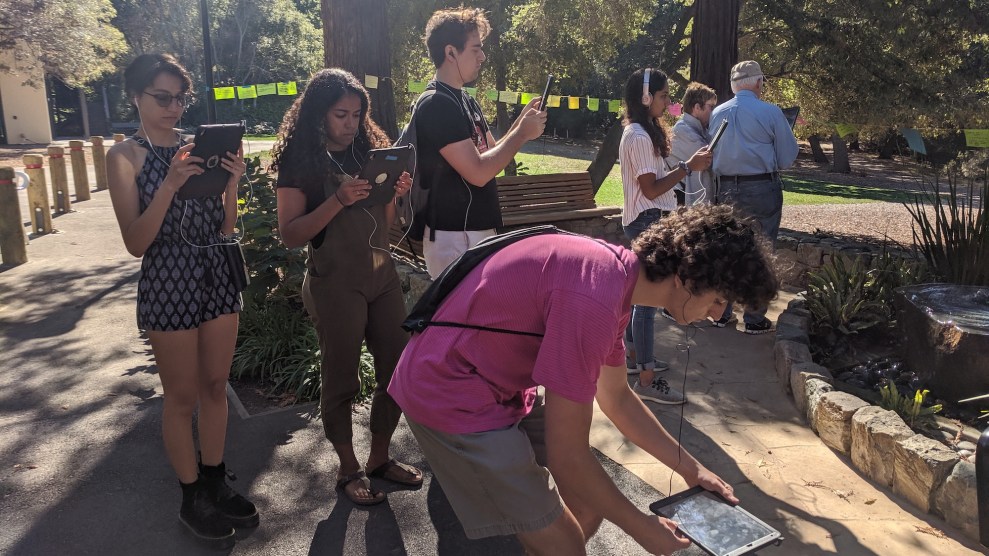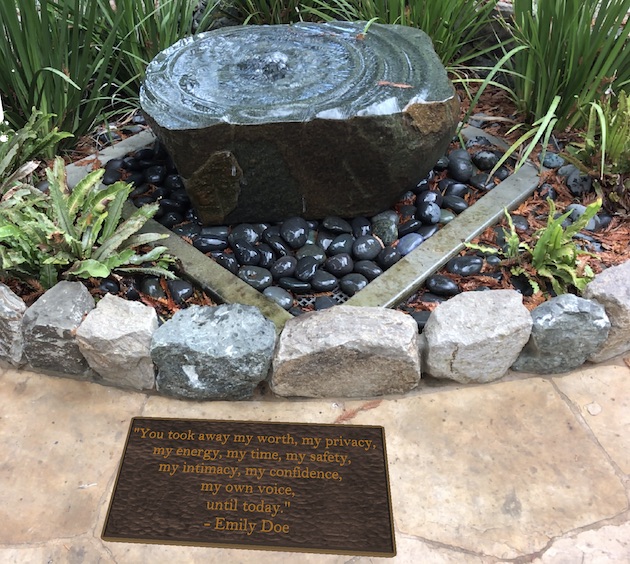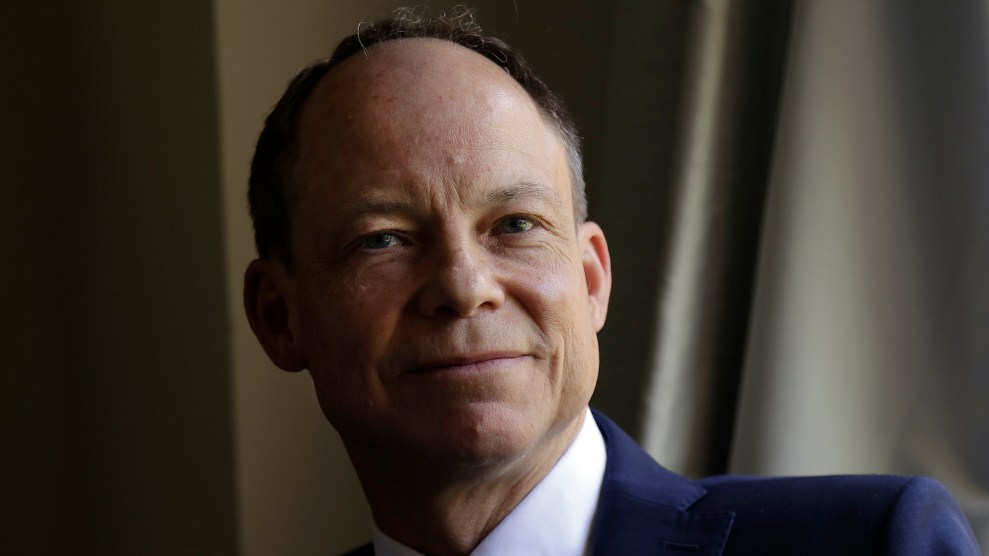
Visitors use an app that creates a digital memorial in a "contemplative garden" on the Stanford University campus.Courtesy Hope Schroeder
Last Friday afternoon, Khoi Le adjusted the gray pipe cleaners keeping his glasses affixed to his face and surveyed the tiny garden at the south end of the Stanford University campus. A small crowd had gathered beneath a stand of pine trees. Water trickled over the edges of a small boulder surrounded by greenery. Small brown birds hopped on a pair of benches and a low retaining wall.
Over the past year, the garden had become an office of sorts for Le, a senior, and the other leaders of StanfordXR, a club for students interested in virtual and augmented reality. They’d spent hours working here on their laptops, building an AR version of the garden while trying to ignore the sounds of drinking games and music blasting from the Kappa Alpha fraternity next door, and, once, the smell of a roasting pig wafting from the yard of a nearby student residence. “Do you know what’s happened here?” Le wanted to ask the partiers. “There are some days when I’m out here, and I’m like, ‘Oh my god, I can’t believe I’m writing code where somebody was sexually assaulted.’”
Four and a half years have passed since the night two Swedish graduate students on bikes spotted a freshman named Brock Turner sexually assaulting Chanel Miller at this spot, behind Kappa Alpha’s dumpster, in the darkness beneath the pines. Turner was arrested and convicted, but he served only three months in jail. Miller’s powerful victim impact statement (published under a pseudonym by BuzzFeed News), generated outcry over Turner’s lenient sentence and fueled a successful campaign to recall the judge.
In the fall of 2016, Miller and Stanford reached an agreement: She would not sue the university, while it would pay her $150,000. It also would replace the dumpster where she was attacked with a “contemplative garden” that included lights for safety and a plaque with an excerpt of her choice from her victim impact statement. Over the next year, Miller writes in her new memoir, administrators shot down each of the quotes she selected. When Miller chose an excerpt that included the line “I had to relearn…that I am not just a drunk victim at a frat party found behind a dumpster, while you are the All American swimmer at a top university,” vice provost Lauren Schoenthaler wrote back that “our agreement was not to condemn a single individual.” When Miller offered another quote that had been widely cited in the media (“You took away my worth, my privacy, my energy, my time, my safety, my intimacy, my confidence, my own voice, until today”), Schoenthaler replied that university counselors concluded it could be “triggering and upsetting” to survivors. She offered three alternatives, including the words Miller had said to her sister after finishing a rape kit exam: “I’m right here, I’m okay, everything’s okay, I’m right here.” Miller stopped participating in the process, and, according to provost Persis Drell, her representative requested the garden make no reference to her at all.
The nameless garden, completed in the fall of 2017, is decorated with wooden benches and dark river pebbles, but no plaque. For the latest cohort of students, according to Stanford behavioral science fellow Jennifer Freyd, there is nothing to connect this shady spot to the viral story that shook the campus just a few years ago. “There are the students who don’t know anything about it, and for them it’s a pretty garden,” said Freyd, who coined the term “institutional betrayal” to describe how organizations like universities can inflict harm on their constituents, including sexual violence survivors. “For students who know the history, it’s understandable that now some of them feel betrayed. If Stanford were to put up the right kind of plaque, that would be institutional courage.”
Le and fellow VR/AR club leaders Hope Schroeder and Kyle Qian hadn’t been following the conflict over Miller’s plaque, which was first reported in an anonymous student publication in early 2018. That changed after they won a $35,000 “Magic Grant” from the Brown Institute for Media Innovation to build an app that could digitally replace Confederate monuments in Charleston, South Carolina, with memorials to civil rights activists. Charleston was nearly 3,000 miles away, so the team needed a local site where they could test a prototype. That’s when they learned about the garden.
“We had a major conflict of public space happening in our own backyard, and we had tools in our hands to do something about it,” said Schroeder, the project’s director. The three set about building an app called Dear Visitor, which virtually installed the plaque that Stanford wouldn’t. According to Le, they worried whether they were using the garden as an excuse to play with augmented reality, so they sought advice from historians and gender violence researchers. They won cautious support from campus administrators and also got Miller’s permission. “In Silicon Valley, tech has this reputation of people just trying to throw technology at things to fix it,” Le said. “What got me through was having friends who were sexually assaulted, being able to kind of give this back to them.”
By midafternoon on the day of the app’s “launch,” the small space around the garden had filled up with people. Qian, carrying a thick stack of iPads, hovered close to the first visitors, peeking at their screens and flashing them thumbs-up. (“It’s like the first steps of a baby,” he apologized.) Inside the app, which is experienced with an iPad and headphones, a gleaming 4-foot tall white monument stood next to the garden’s entrance, bearing Miller’s first chosen quote in golden letters; the second quote was inscribed on a plaque at the fountain’s foot. Tapping either excerpt played a recording of Miller reading from her statement. Above the fountain, flashing envelopes suspended in midair played interviews with students reflecting on Miller’s statement or the conflict over the garden.

The team had decided to release Dear Visitor as a one-time art installation. “This kind of experience is really emotionally taxing,” Le said. “In augmented reality, you’re starting to believe the digital objects are actually around you. But when the technology’s removed, suddenly you’re rushed back.” To help participants process their emotions after using the app, the team set up tables outside the garden where participants could write open letters responding to the experience, which Le planned to post on the Dear Visitor website.
When one student became emotional after finishing her walkthrough, Schroeder spoke to her quietly, assuring her she didn’t have to write a letter if it was too overwhelming. “I just don’t want to rush it,” the student said. “It’s a lot,” Schroeder nodded. She pointed her to another table, where students could make signs with quotes from Miller’s statement and hang them from a clothesline strung between the trees. “Maybe this would be a better activity, so you don’t have to bare your soul.”
Grace Dong, a senior majoring in symbolic systems, scribbled furiously at the letter-writing table, brow furrowed. “All of this started when I was in high school,” she said. “You have countless Stanford girls, women, 18-year-olds walking around this campus, and they know where not to walk. They know what not to do because of what happened to Chanel. It’s really disappointing that Stanford’s letting that happen.”
When Susie Brubaker-Cole, the vice provost for student affairs, arrived to tour the garden, the app developers watched her cautiously. Two days earlier, she had sent an email to the student body offering a “processing circle,” counseling, and trauma-sensitive yoga sessions to students struggling with feelings brought up by the release of Miller’s memoir. “We acknowledge that even on our campus, people can be harmed by others,” the email said. Brubaker-Cole fidgeted with the strap of her backpack as she listened to the recordings, then sat down alone to write a letter, which she didn’t sign. She wouldn’t speak with me, but before she left, she told Schroder that listening to the student voices helped her get a lot of “context” on the issue.
Up the hill from the garden, Michele Dauber, the Stanford law professor who led the campaign to recall Turner’s judge, held court with a small circle of gender studies professors. They discussed the merits of comparing the garden to a Holocaust memorial—a memorial ought to be “triggering,” they agreed, if it makes passerby stop and think—and criticizing Stanford’s handling of campus sexual assault. “They don’t see this as an atrocity,” Dauber said. “They see this as a miscommunication that happens over and over again.” She paused to introduce a student walking her bike up the slope, Betsy Kim, a sophomore who took Dauber’s class last year.
“She likes younger students so she can radicalize us early,” Kim said with a grin. “Oh no, no,” Dauber cut in hurriedly. “So I can teach them. Don’t use the word radicalize.”
Down the hill, Schroeder summoned the crowd of nearly 50 people to form a circle. One by one, participants stepped forward to read from Miller’s victim impact statement. Dressed in a “Fuck Rape Culture” T-shirt, Lezli Logan, a co-chair of the recall campaign, chose a passage about Miller losing her sense of independence. “I know this feeling well,” Logan told the circle before reading from Miller’s statement: “It is embarrassing how feeble I feel, how timidly I move through life, always guarded, ready to defend myself, ready to be angry.” When she finished, she was met with quiet snaps of support.
Back in the garden, Jessie Verhein, a MD-PhD student, shared a pair of headphones with a friend who was worried about giving her name, since her academic field had been rocked by a series of sexual misconduct scandals. “You can recover from one,” the friend said, sighing. But once a new incident is reported, “you have to spend an entire night reading about it, and get really mad.”
The two had been at Stanford longer than any of the current undergraduates, long enough to remember when Miller was known as “unconscious intoxicated woman” and then “Emily Doe”; when the site of the garden was still a frat’s dumpster. “I’m so mad that there isn’t a plaque,” Verhein said. Before today, she had avoided visiting the garden. “I guess everywhere you walk on earth, probably something terrible happened there, but—it feels weird.”
“Especially because it’s so clean and polished and nice,” her friend added. They sat for a while under the trees. If Stanford doesn’t install a plaque here, Verhein said, she’d like to leave a copy of Miller’s book, or maybe handwritten notes tucked into the stonework. “If nothing happens,” she suggested, “we can put something in a tree.” Her friend nodded. “Bring a Sharpie.”











